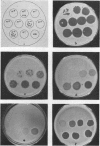Abstract
The nature of the phage typing reactions on Brucella species was determined by rates of adsorption and infection, one-step growth experiments, and susceptibility to lysis from without. The highest rates of adsorption and infection were obtained on smooth B. abortus cultures, and large clear plaques were produced. One or a few phage particles per B. neotomae cell killed about one-half of the cells, but some went through an infective cycle and released mature phage that resulted in production of small clear plaques. With B. suis, more phage particles per cell were required to kill, replication did not occur, and plaques were not observed. Still greater numbers of phage particles were required to cause some inhibition of growth of B. melitensis lawns. Rough Brucella cultures and species, such as B. ovis and B. canis, were not affected by the highest concentrations of phage. B. abortus cultures of intermediate colonial morphology adsorbed phage, but only a few infected cells (after a delayed latent period) released mature phage. An infected culture or colony appeared normal until spontaneous phage mutants appeared which could penetrate the cell wall more effectively than the parent phage. The mutant phage multiplied more rapidly, and the colony changed to a sticky white form.
Full text
PDF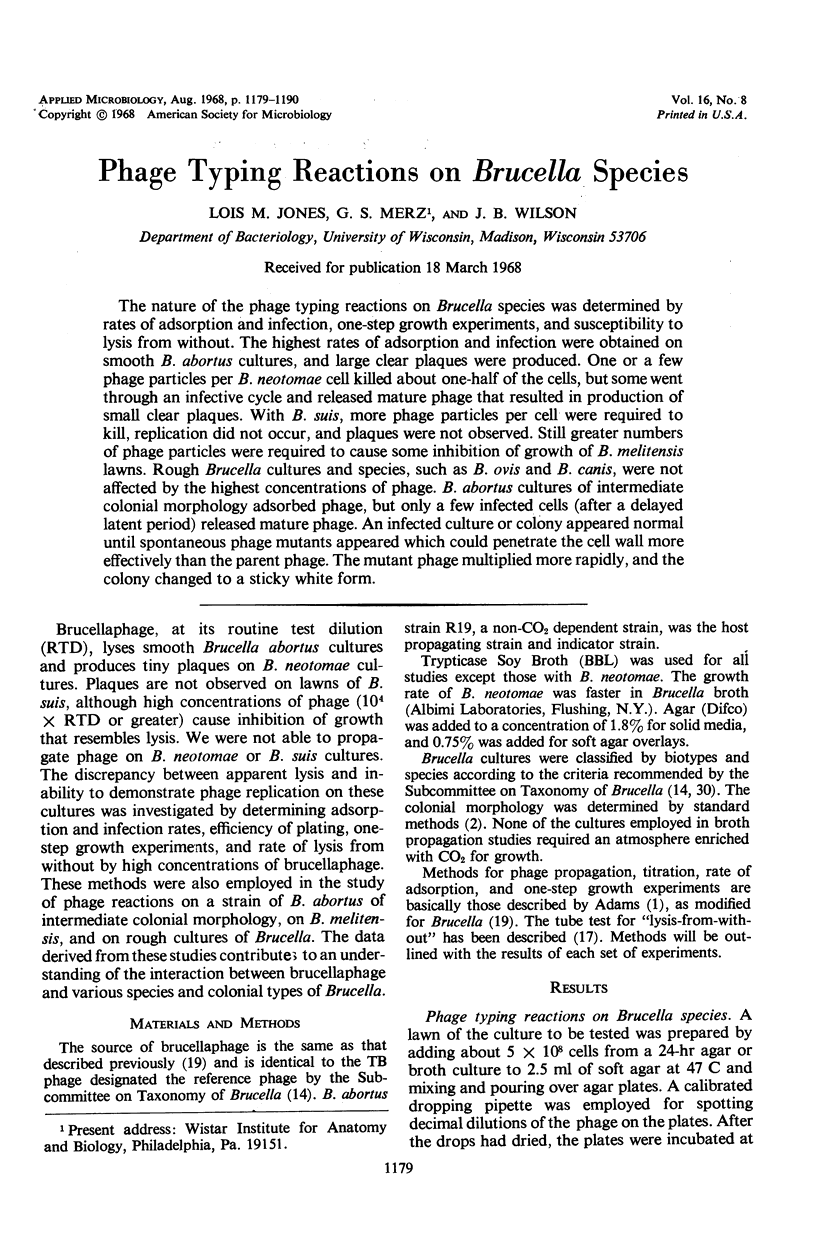
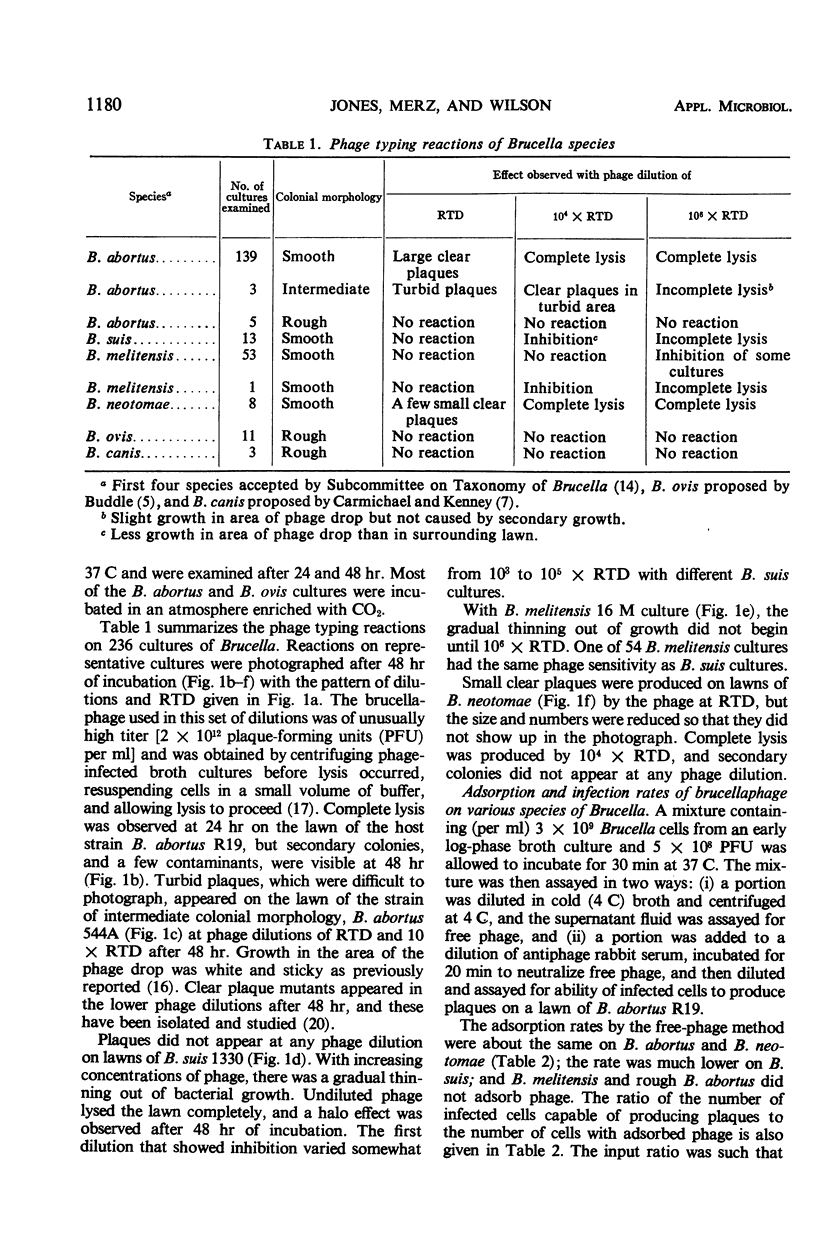
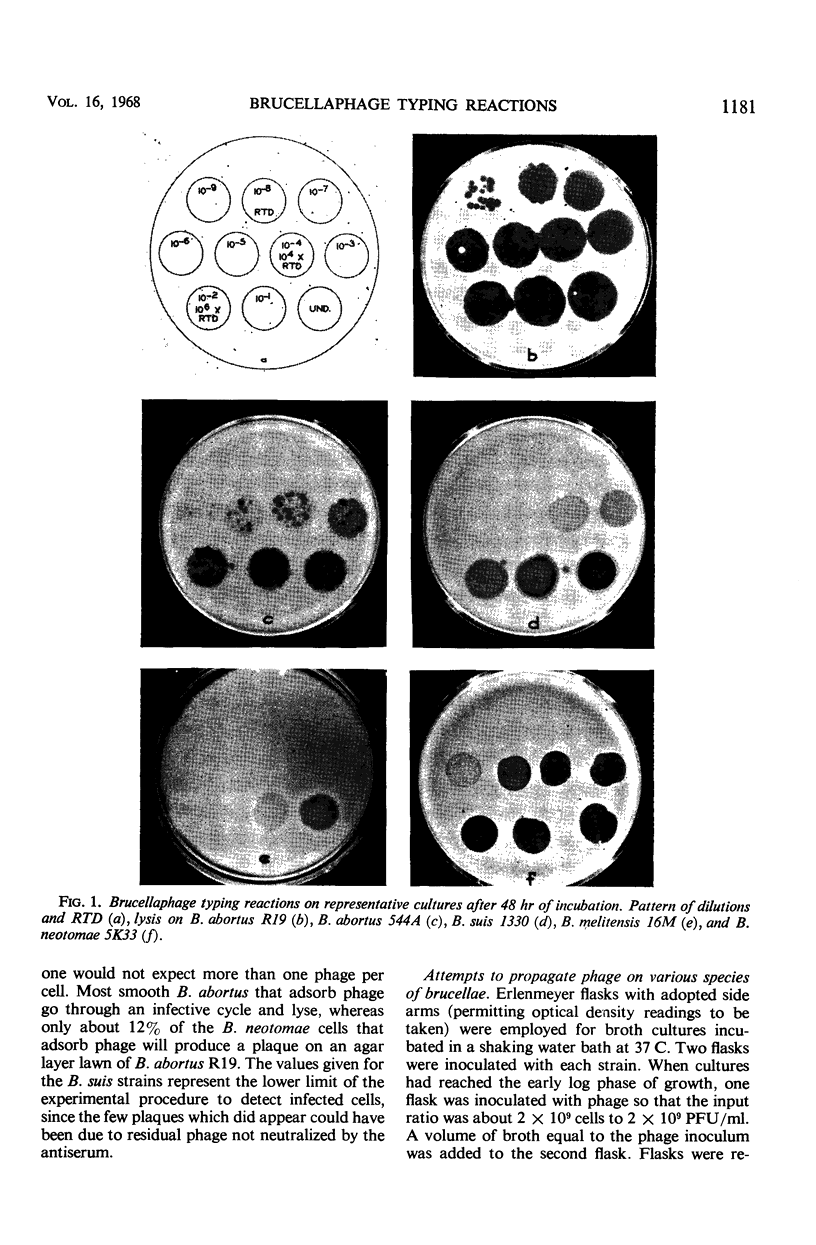
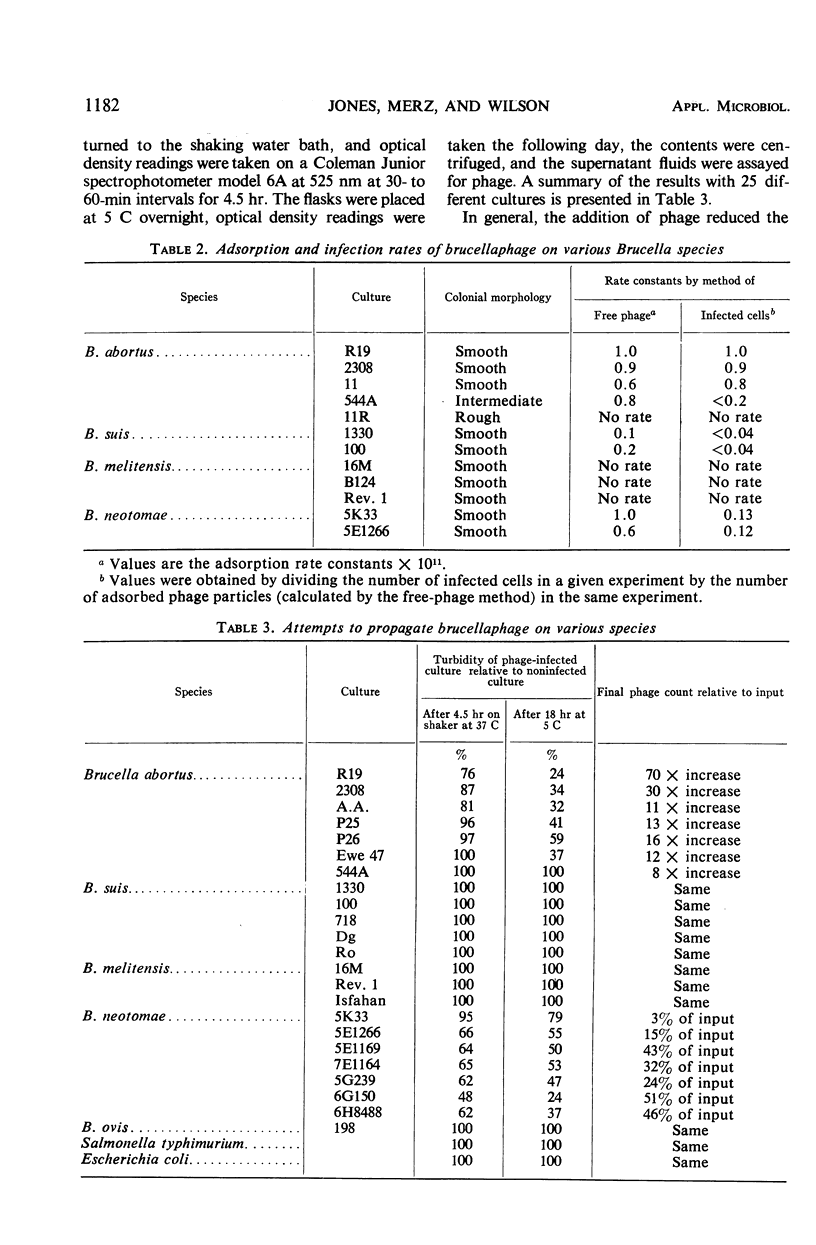
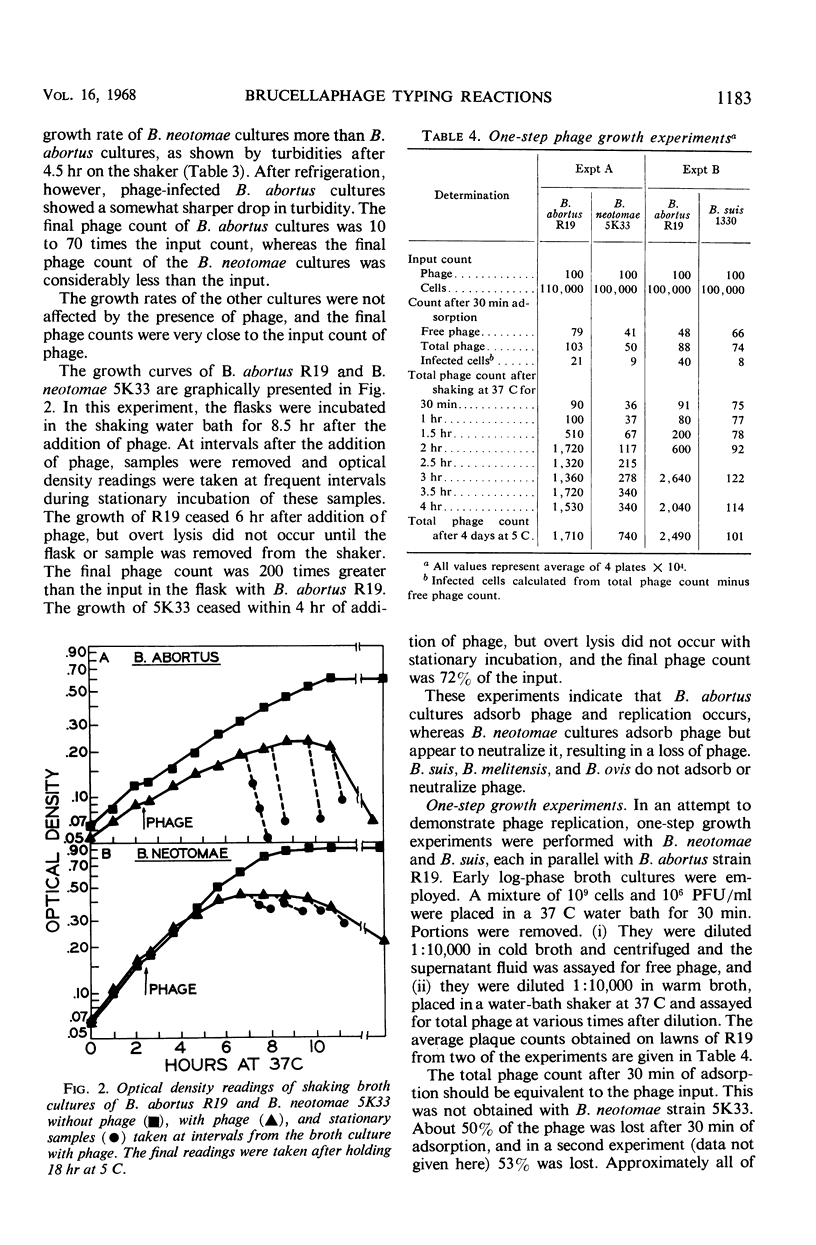
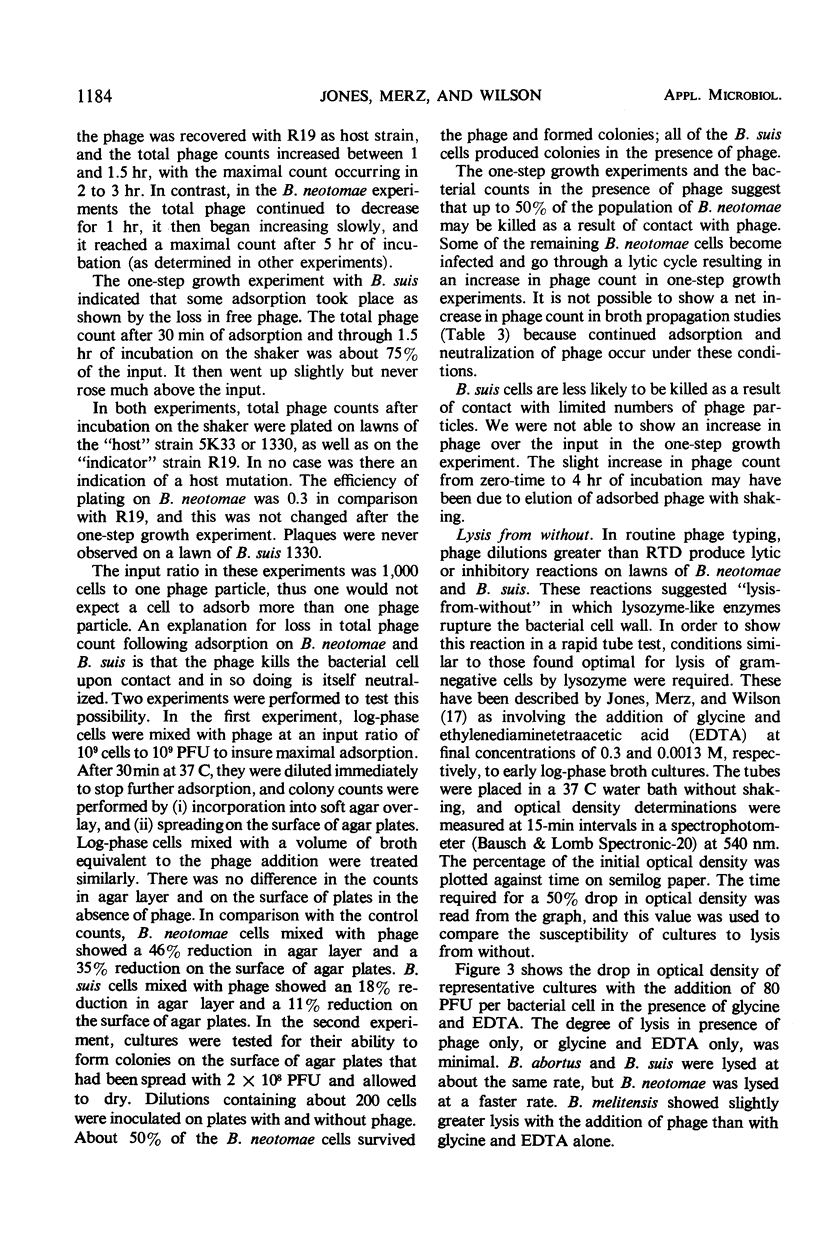
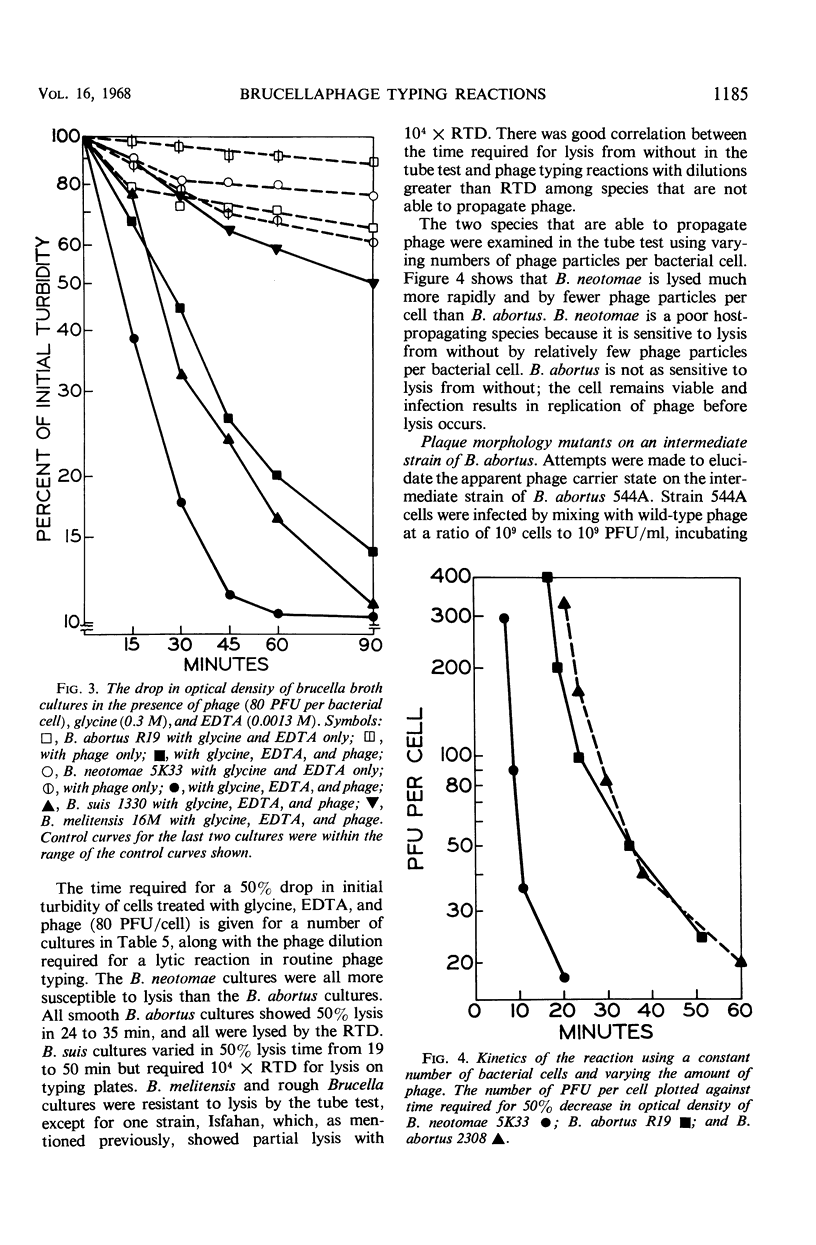

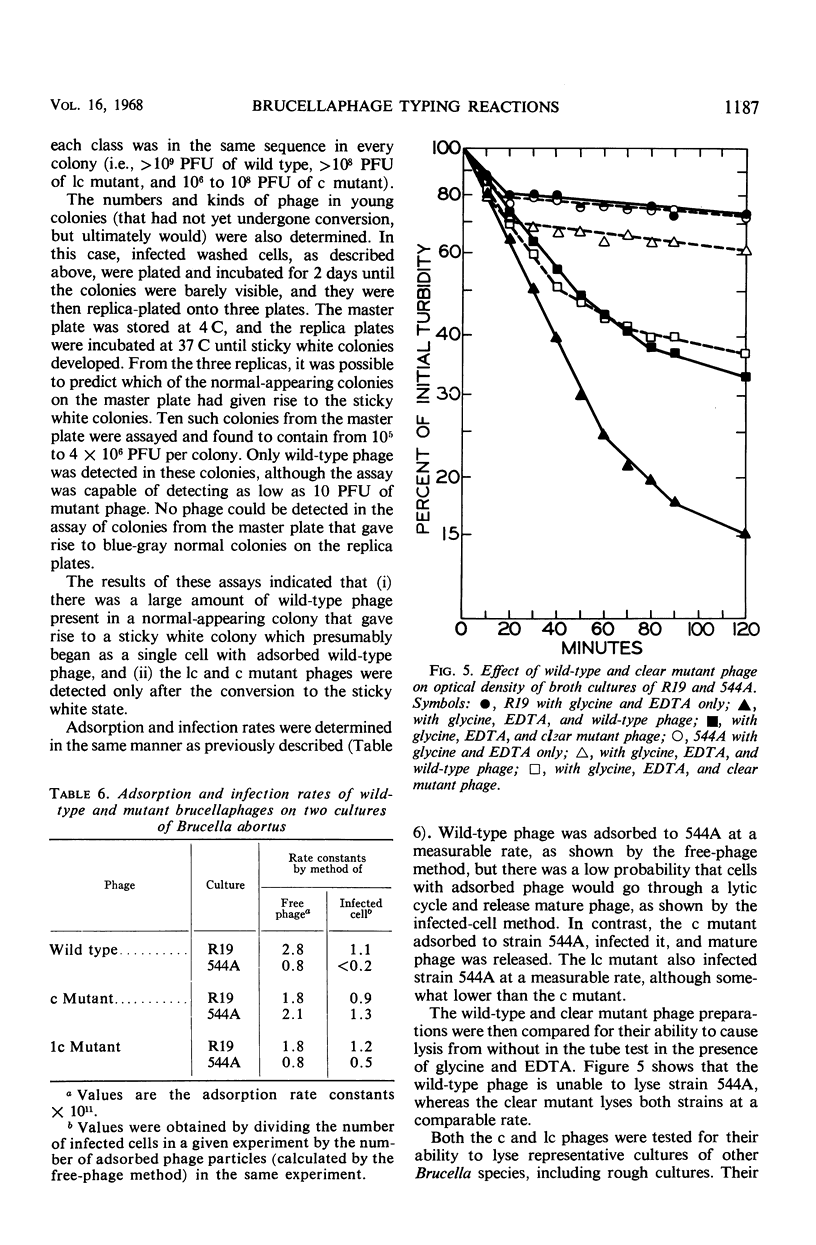
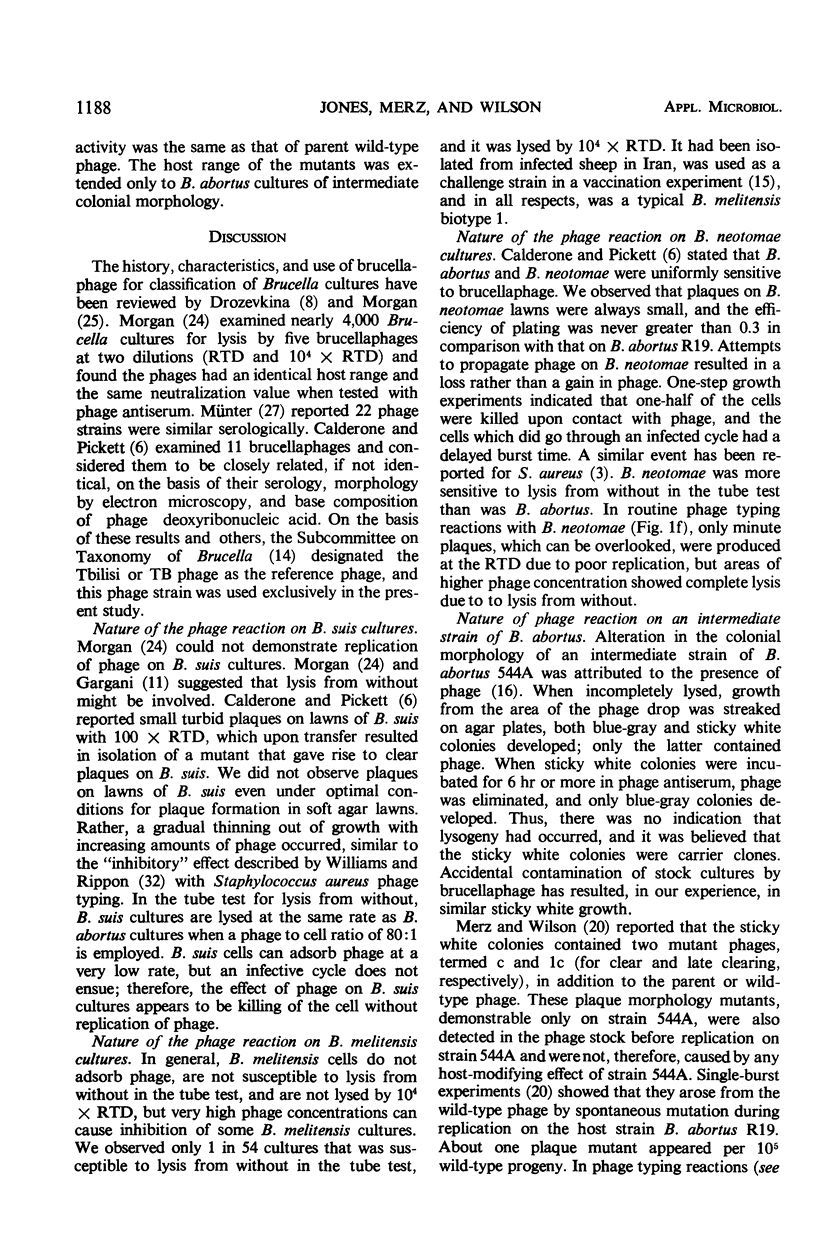
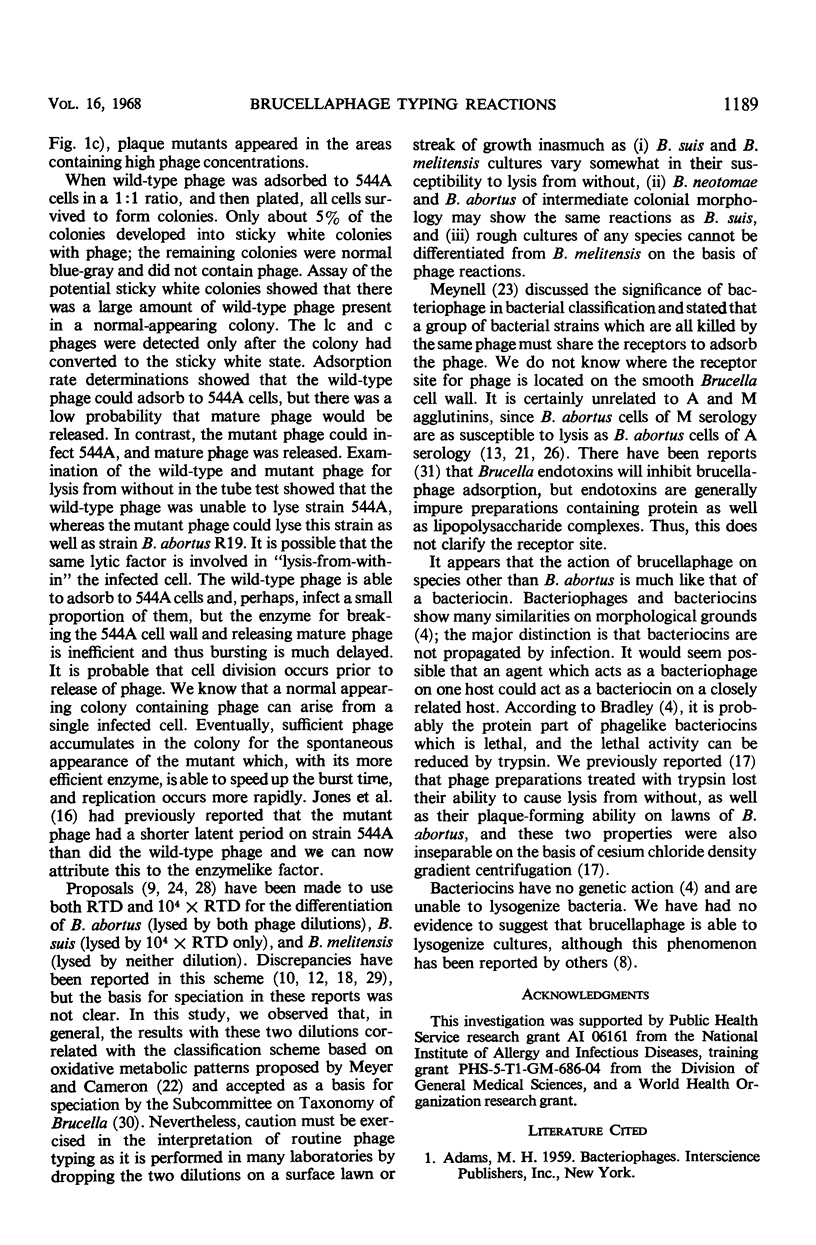
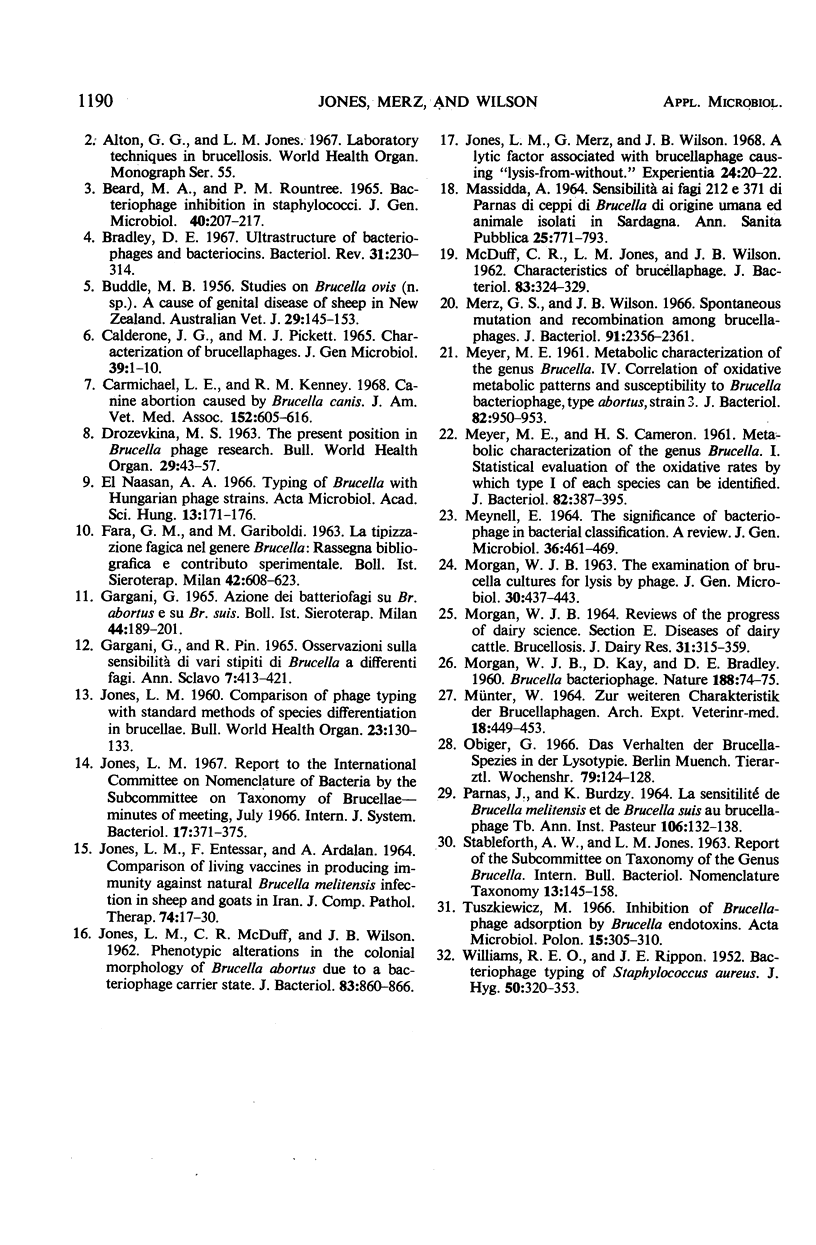
Images in this article
Selected References
These references are in PubMed. This may not be the complete list of references from this article.
- Beard M. A., Rountree P. M. Bacteriophage inhibition in staphylococci. J Gen Microbiol. 1965 Aug;40(2):207–217. doi: 10.1099/00221287-40-2-207. [DOI] [PubMed] [Google Scholar]
- Bradley D. E. Ultrastructure of bacteriophage and bacteriocins. Bacteriol Rev. 1967 Dec;31(4):230–314. doi: 10.1128/br.31.4.230-314.1967. [DOI] [PMC free article] [PubMed] [Google Scholar]
- CALDERONE J. G., PICKETT M. J. CHARACTERIZATION OF BRUCELLAPHAGES. J Gen Microbiol. 1965 Apr;39:1–10. doi: 10.1099/00221287-39-1-1. [DOI] [PubMed] [Google Scholar]
- Carmichael L. E., Kenney R. M. Canine abortion caused by Brucella canis. J Am Vet Med Assoc. 1968 Mar 15;152(6):605–616. [PubMed] [Google Scholar]
- DROZEVKINA M. S. THE PRESENT POSITION IN BRUCELLA PHAGE RESEARCH. A REVIEW OF THE LITERATURE. Bull World Health Organ. 1963;29:43–57. [PMC free article] [PubMed] [Google Scholar]
- FARA G. M., GARIBOLDI M. LA TIPIZZAZIONE FAGICA NEL GENERE BRUCELLA. RASSEGNA BIBLIOGRAFICA E CONTRIBUTO SPERIMENTALE. Boll Ist Sieroter Milan. 1963 Nov-Dec;42:608–623. [PubMed] [Google Scholar]
- Gargani G. Azione dei batteriofagi su Br. abortus e su Br. suis. Boll Ist Sieroter Milan. 1965 Jul-Aug;44(7):189–201. [PubMed] [Google Scholar]
- JONES L. M. Comparison of phage typing with standard methods of species differentiation in brucellae. Bull World Health Organ. 1960;23:130–133. [PMC free article] [PubMed] [Google Scholar]
- JONES L. M., ENTESSAR F., ARDALAN A. COMPARISON OF LIVING VACCINES IN PRODUCING IMMUNITY AGAINST NATURAL BRUCELLA MELITENSIS INFECTION IN SHEEP AND GOATS IN IRAN. J Comp Pathol. 1964 Jan;74:17–30. doi: 10.1016/s0368-1742(64)80003-5. [DOI] [PubMed] [Google Scholar]
- JONES L. M., McDUFF C. R., WILSON J. B. Phenotypic alterations in the colonial morphology of Brucella abortus due to a bacteriophage carrier state. J Bacteriol. 1962 Apr;83:860–866. doi: 10.1128/jb.83.4.860-866.1962. [DOI] [PMC free article] [PubMed] [Google Scholar]
- Jones L. M., Merz G. S., Wilson J. B. A lytic factor associated with brucellaphage causing "lysis-from-without". Experientia. 1968 Jan 15;24(1):20–22. doi: 10.1007/BF02136766. [DOI] [PubMed] [Google Scholar]
- MASSIDDA A. SENSIBILIT'A AI FAGI 212 E 371 DI PARNAS DI CEPPI DI BRUCELLA DI ORIGINE UMANA ED ANIMALE ISOLATI IN SARDEGNA. Ann Sanita Pubblica. 1964 Jul-Aug;25:771–793. [PubMed] [Google Scholar]
- MEYER M. E., CAMERON H. S. Metabolic characterization of the genus Brucella. I. Statistical evaluation of the oxidative rates by which type I of each species can be identified. J Bacteriol. 1961 Sep;82:387–395. doi: 10.1128/jb.82.3.387-395.1961. [DOI] [PMC free article] [PubMed] [Google Scholar]
- MEYNELL E. THE SIGNIFICANCE OF BACTERIOPHAGE IN BACTERIAL CLASSIFICATION. A REVIEW. J Gen Microbiol. 1964 Sep;36:461–469. doi: 10.1099/00221287-36-3-461. [DOI] [PubMed] [Google Scholar]
- McDuff C. R., Jones L. M., Wilson J. B. CHARACTERISTICS OF BRUCELLAPHAGE. J Bacteriol. 1962 Feb;83(2):324–329. doi: 10.1128/jb.83.2.324-329.1962. [DOI] [PMC free article] [PubMed] [Google Scholar]
- Merz G. S., Wilson J. B. Spontaneous mutation and recombination among brucellaphages. J Bacteriol. 1966 Jun;91(6):2356–2361. doi: 10.1128/jb.91.6.2356-2361.1966. [DOI] [PMC free article] [PubMed] [Google Scholar]
- Meyer M. E. METABOLIC CHARACTERIZATION OF THE GENUS BRUCELLA IV. 3: Correlation of Oxidative Metabolic Patterns and Susceptibility to Brucella Bacteriophage, Type abortus, Strain. J Bacteriol. 1961 Dec;82(6):950–953. doi: 10.1128/jb.82.6.950-953.1961. [DOI] [PMC free article] [PubMed] [Google Scholar]
- Obiger G. Das Verhalten der Brucella-Spezies in der Lysotypie. Berl Munch Tierarztl Wochenschr. 1966 Apr 1;79(7):124–128. [PubMed] [Google Scholar]
- PARNAS J., BURDZY K. LA SENSIBILIT'E DE BRUCELLA MELITENSIS ET DE BRUCELLA SUIS AU BRUCELLOPHAGE TB. Ann Inst Pasteur (Paris) 1964 Jan;106:132–138. [PubMed] [Google Scholar]
- Tuszkiewicz M. Inhibition of Brucella-phage adsorption by Brucella endotoxins. Acta Microbiol Pol. 1966;15(4):305–309. [PubMed] [Google Scholar]
- WILLIAMS R. E. O., RIPPON J. E. Bacteriophage typing of Staphylococcus aureus. J Hyg (Lond) 1952 Sep;50(3):320–353. doi: 10.1017/s002217240001963x. [DOI] [PMC free article] [PubMed] [Google Scholar]
- el Naasan A. A. Typing of brucella with Hungarian phage strains. Acta Microbiol Acad Sci Hung. 1966;13(2):171–175. [PubMed] [Google Scholar]



